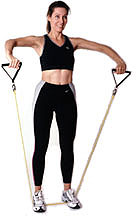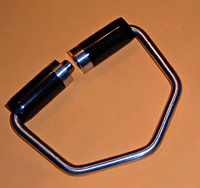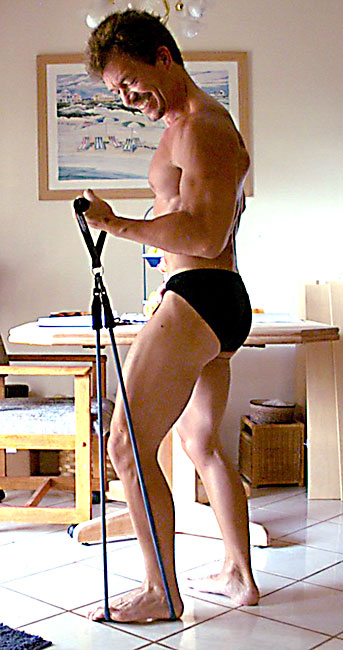
|
PRE-CONTEST
SPECIAL ADVICE
|
How
Many Calories?
The number of calories you burn each day varies depending on body weight,
body composition, metabolism and activity level.
More important than how many calories you consume is what you consume. You can't carry muscle and get ripped eating junk food. If you don't eat clean, for a long period of time (months) you won't lose the fat and become truly ripped.
Many people have no idea how many calories they require simply to maintain their weight and, as a result, they tend to cut calories too much when they attempt to lose body fat. There's a rule-of-thumb formula for estimating how many calories you burn at rest. For men: Add a zero to your weight and then add twice your weight. For women: Add a zero to your weight and then add your weight.
Using the formula if you weighed 175 pounds, your expected resting calories needs would be 2,100 a day. (To 175 add a zero, giving you 1,750, and to this figure add two times 175, or 350, for a total of 2,100.)
This is an estimate of the number of calories it would take to maintain your weight if you did nothing but vegetate. To determine total calorie needs, you have to add calories for general activity and exercise. With your desk job and workouts, you probably burn one-half again your resting needs, for a total of 3,150 calories (2,100 plus 1,050 equals 3,150). If you were engaged in a regular aerobic exercise program, you would require more calories. On the average, walking or jogging a mile consumes about 100 calories.
As general information, you'll be interested to know that, according to the National Research Council, the average woman (5'4", medium frame, not too thin, not too fat) who does not exercise needs 1,600-2,400 calories a day to maintain body weight. The average man requires 2,300-3000 calories a day to do the same.
Find your calorie level, and maintain an eating journal, counting your calories carefully. Start off with a slight calorie deficit (200 calories) and work with that as long as possible. Several months of daily aerobics, and a slight calorie deficit diet will take off the body fat.
PRE-CONTEST
EATING
Plan to diet
for 8 to 4 months
Eat 30 grams of protein every 3 hours, 5 times or more every day.
1 to 2 grams of protein for each pound you weigh. At the minimum 5 protein
meals a day. Try to eat 3 times before noon every day. Consuming
whey protein and other protein type shakes can help you achieve your daily
protein intake level.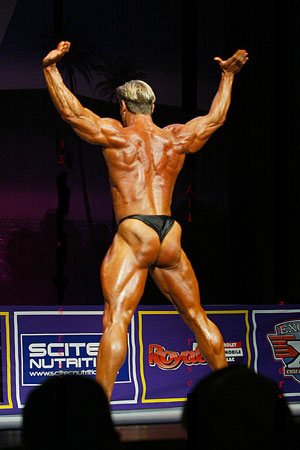 Everything
else you eat should be clean complex carbs. To name a few: brown rice,
rice, corn, vegetables, whole wheat oatmeal, pasta and other items, and
fruit.
Everything
else you eat should be clean complex carbs. To name a few: brown rice,
rice, corn, vegetables, whole wheat oatmeal, pasta and other items, and
fruit.
Drink water all day long. It is the best fat burner I know. Drink, drink, drink.
Dairy products should be eliminated in the final months or weeks and replaced with other protein sources free of carbs and fats.
Carbs are kept between 2 and 4 servings of 100 gms each per day. That is between 200 and 400 total grams of carbs a day. Eat all your carbs before 3:00 every day. Eat the majority of carbs early in the day. Make breakfast #1 and breakfast #2 and lunch (to a lesser degree) the biggest carb meals of the day. Brown rice, vegetables, fruits and whole wheat oatmeal, ect are good sources of carbs.
I like to eat a lot. I like don't like being hungry. I would rather eat an extra 500 calories a day and do an aerobic session to burn it, than be hungry. Amazingly the more you eat (of clean food) the more body fat you will lose. The body does not hoard fat when you are eating a lot and being active.
How about fats?
As low as you can go. There are fats in meats, nuts, and dairy products
and many other foods, so you have to be aware of how much fat you are
taking in. 50 to 100 grams a day or less in fats per day is recommended.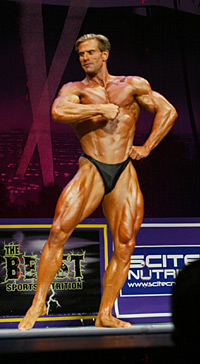
Always eat a protein and carb within 30 minutes after you train (even if it's at night).
Eat salad and fibrous carbs daily. They have almost no calories and help your body stay healthy. Salad (containing carrots, lettuce, spinach, cucumber, radish, tomato, celery) and other raw vegetables and even cooked green vegetables can be eaten in large quantities without any negative effects. Consider them zero calories.
Juice, bread, pasta and other simple sugars and carbs should be avoided. Fruit is okay with breakfast (like a banana or orange or melon) but might be eliminated completely during the last months or weeks and replaced with a more complex carb like oatmeal. If you eat breads and pastas try to quit them the last month (at least) before the show and switch to other carb sources.
During the last month or weeks eliminate "sauces" like ketchup mustard, dressings, fake butters, flavored rices, and so on.
During the last month or weeks eliminate protein shakes and replace them with solid protein foods like chicken or fish.
| DAILY FOOD INTAKE for LEE APPERSON • Bodyweight 245 lbs. | |||||||||||||||
| MEAL 1 |
|
||||||||||||||
| MEAL 2 |
|
||||||||||||||
| MEAL 3 |
|
||||||||||||||
| MEAL 4 |
|
||||||||||||||
| MEAL 5 |
|
||||||||||||||
| MEAL 6 |
|
||||||||||||||
The
Final Month: PEAKING
If
you did it right you are in good shape by now. Abs should be in. Shoulders
should be separated. You should need to lose less than 5 lbs now, if that,
before you compete.You should be close to contest weight and in very hard
condition. If not you are not all of these things---YOU ARE NOT ready
to peak. (Go back and reset your peaking time table you need more
time).
You should be posing every few days, as hard as possible for 10
to 30 minutes. Pose with someone coaching you, calling out the poses.
The final month you must eat as clean as possible. Don't eat anything that can make you fat. Drop ketchups, flavored rice, and so forth from your diet. Replace whey shakes with whole foods like fish or chicken. Drink water all day long. Drop carbs at night.
If you
are too fat, do not go on a starvation diet. It's too late. If anything
train more and do more gentle aerobics. If are fat--plan on competing
in a different show. Do not compete fat either. Be patient. Stick
with the plan and just keep getting more ripped over time. It may be 2
months it may be 8 months, but if you stick to the plan (eating clean
with a slight calorie deficit, daily aerobics and weight training 2 x
a week or more) you will become ripped. Sooner or later all the fat will
come off.
Assuming you are at a low body fat level you can start thinking about
getting ready to compete and dialing in the final weeks.
Now that the fat is nearly 98% gone, here are some tips for the final
month. Some of the suggestions contradict each other. However all
of them are valid techniques, you need to figure out which ones will work
for you.
-
Train each body part 2 or 3x a week with medium weights and lots of reps for the last 4 to 6 weeks. This really helps harden you up and helps burn calories. Beware! Do not over train and burn out. If you feel yourself getting frazzled, back off.
-
Train as normal the last and try to lift heavier the last few weeks to keep or increase--your muscle mass. Avoid over training.
-
Train legs and back every day for 3 days, rest a day and repeat this schedule for 2 or 3 weeks, then rest a complete 10 to 7 days before the show, doing only posing and abs. (Some people look better 10 days off of the weights. They get more separated and ripped about 2 weeks after training hard. By practice see if you respond like this. Monitor yourself carefully. Lee Apperson rests 10 days out from a show and by day 9 is MUCH more ripped than you can believe. For many people the rest really works.) Some people of course look worse after 2 weeks off from the gym. I would guess it's 50% either way.
-
Train up till the Sunday before the show and then rest the entire week.
-
Train up till the Wednesday before the show and then rest the rest of the week.
-
Stop all aerobics, or do more aerobics. Some people respond to stopping aerobics by getting bigger, others not. Find out which one you are. Lee Apperson does no aerobics the last month. Other bodybuilders step up the aerobics and it helps them tighten up without effecting muscle size. Discover which type you are.
-
Pose several times a week. Focus on muscle control. Do posing sessions just for your legs (posing them alone) and abs.
-
No carbs at night.
Yes, you must practice peaking yourself. A great way to do this is either run experiments on yourself and check results yourself (practice dehydration ect..) or compete several weeks or months in a row and practice different peaking techniques at different times.
You will
find the combination that works best for you. Each person will have a
slightly different formula for success. A good example of this is dehydration
schedules. For some people dehydration works and for some it just flattens
them out. If it does work for you, it may take you 1 day to dry out, or
even 2 days. You have to discover your optimum look and keep records so
you create that condition, over and over again when you want to peak.
Some common peaking problems and questions:
QUESTION: I have been dieting for 14 weeks. I find I am shrinking and not losing any more body fat. What can I do?
ANSWER: You may need to add more calories in your diet. You may also be on a diet plateau. Also after months on a strict diet your body stops being responsive. The answer is often to eat more and increase activity. Your metabolism needs to be cooking--to burn fat and use energy.
Add a meal or two of red meat and whey protein each day for 2 weeks and see how you respond. You may need to up carbs as well. You may also need more vitamins and minerals in your diet on top of the additional calories. If you increase calories you may increase training or aerobics as well slightly to offset the calories. Try to eat a variety of foods including fruit to make sure your body is not depleted of many trace elements. 2 weeks of eating better and your body should fill out and you should start losing fat again.
QUESTION: I am in very good shape. My upper body and legs are cut and hard but I still have some fat on my lower back and buttocks. What can I do?
ANSWER: These are the last places the fat comes off on many people. Abs, and side thighs are difficult areas as well. These trouble spots take a long term effort to finally diet and train the fat off of. The plan is to eat well, maintain your muscle mass with hard weight training, eat very clean so no new fat is created, then train (aerobics and weights) for several more months or weeks, and it will come off. It takes time.
For the most part a long more gentle diet carried on for a month to a year or more--- after the initial first year, big weight loss diet, will fine tune these problem areas without shrinking your muscles. Don't starve yourself or use crash diets. You will just shrink your muscles. You have to get in top shape as part of a long term plan.
QUESTION: I have been dieting for months. I am in good shape but I just don't seem to get hard or cut enough. What can I do?
ANSWER: First: Pose every other day for several months. It helps harden the muscles.
Second: Diet
longer and harder. I meet a great many athletes that think they are ripped
but are still about 5 or 10 pounds of fat away from being really in shape.
For whatever reason they don't see themselves in reality. These fellows
are invariably quoting body fat levels and so on. To get cut you have to
diet longer and harder than you think. Find a coach to help you face the
facts. Anyone can do it. It just takes time. Commit now to taking it all
off, no matter how long it takes. Forget "time tables" just
stay on your program and the fat will burn off--sooner or later.
Ex-fat people have trouble getting hard, as do most women. You have to
train more often, and diet longer and harder than most people to get results.
Just stay with it. You will get harder. It will happen. The fat will come
off.
After a long time on a diet the body grows tired of the diet and results slow down. As stated above an infusion of different foods and red meat often helps kick start the body again into being responsive to exercise and calorie restricted eating. Many people get more and more cut for a time on a diet..like 3 months or more then results stop. You have to figure out did results stop because you are eating too little? too much? too much the same (no variety)? Have you gone stale (too much training)? Or do you need to increase activity? You have to answer these questions and then take appropriate action.
99% of the time eating more good clean food, eating more food variety, adding more vitamins and minerals, and increasing aerobic activity, will cause a long term training and strict dieting person to continue to lose fat--again. You need to jump start your metabolism with an infusion of food and activity.
THIRD: You might have a " food leak"--that is sinking your ship. You are eating something that is making you fat. You are eating something that your body is using to keep making fat. It might be dairy products or fruit or pasta or cereal. You will have to find this food, and replace it with a food that your body does not easily make into fat.
Examples: Replace milk with a chicken breast. Replace eggs with fish. Replace bread with vegetables. You take a clean food like whole wheat pancakes and swap it out for a cleaner food like broccoli. You take red meat and swap it out for whey or fish. You take peanuts and swap them for egg whites, and so on. Often, one (incorrect for you) food consumed with regularity can stop you from losing fat.
QUESTION: What about low carb diets?
ANSWER: They work. But you can't live on them. A couple week's is tops on a diet like this for most athletes. You may feel tired, and even sick on a diet like this, it's hard to train and you can lose muscle along with the fat. However, done correctly, a diet like this can have dramatic results. If you are eating enough protein you will probably hold onto your muscles as the fat comes off. Frank Zane diets this way and does well with it. I have met several very experienced bodybuilders who look great and have been competing for years who use this to great success.
Modern bodybuilders, like myself (Lee Apperson) and Dexter Jackson, eat more of a balanced diet as part of a long term lean life style. Toward a show I reduce carbs like fruit and breads and switch to more fibrous carbs, but I still eat carbs at nearly every meal. The last month I cut out carbs at night and become much more cut.
Experiment with a low carb diet and see how it affects you. As a last month plan to take off the last few pounds of fat---it might be the way to go. Many serious and experienced bodybuilders swear by this method of stripping fat off the body.
Other bodybuilders use this method to jump start a diet. They begin their diet LOW CARB. They live on the diet for several months (having one high carb a day every 4 to 7 days) to take off the initial weight, then switch to more balanced eating (but calorie restricted diet) for the last several months to peak. No matter how you do it--be careful. This type of dieting can leave you exhausted and mentally confused. Others seem to be fine on a low carb diet. Find out how you tolerate this type of dieting carefully.
The
Final Week: Here are two case studies:
STUDY ONE: Bodybuilder A
is 180lbs in ripped shape. He finds doing aerobics up until the last few
days helps him peak. He eats red meat daily to keep his size and eats
nearly 3400 calories a day. He eats 500 to 300 grams of carbs a day with
the rest in protein. He sometimes does aerobics twice a day. He lifts
2 to 3 times a week doing each body part once a week. He trains abs daily
starting 8 weeks out from his peak.
He eats the normal amounts of food till the Thursday before the show. Thursday and Friday he eats "lightly", focusing on carbs every 3 hours with small amount of protein. He over drinks water for 3 days and then cuts it off Thursday morning before the show (The show is on Saturday 2 days away). Except for small sips, he is off liquids till Saturday. He stops (almost) solid proteins as well, except for small servings of chicken with rice or some egg whites (high in sodium be careful). He eats as little sodium as possible Wednesday, Thursday and Friday. By Saturday morning he is very dry and much more cut. He now weighs around 172lbs. By Saturday night he is even more cut. On Saturday after the prejudging he eats a half a roasted chicken for lunch, along with some bread and one glass of water. He also poses that afternoon for an hour in the sun for photographs. He sweats a lot and again drinks 8 oz of water around 3:00.
Bodybuilder
A gets a good haircut
on Monday and also removes all the unwanted hair on his body with a hair
remover cream. He is very tan from 2 months of daily tanning. On Wednesday
night he paints himself with Pro-Tan. On Thursday he paints himself once
again and tans again for an hour. On Friday he paints himself twice. On
Saturday morning (competition day) he apply's a coat of Dream Tan before
posing. He is
the darkest man in the show.
Thursday and Friday should be rest days (except for posing). Stay off
your feet. The exception is you must pose intensely for short periods
both Thursday and Friday (and Monday or Tuesday earlier in the week) before
the show. Really go for it, posing hard. The legs, abs and other parts
really benefit from this pre contest posing. Don't over do it. You may
go "stale" (lose touch with the muscles) from too much posing.
Find out how much is too much and stay away from that amount. On Thursday
and Friday Bodybuilder A poses for 10 minutes twice a day, and
naps every afternoon resting as much as possible. He eats carbs, brown
rice, potatoes, fruit with small amounts of boiled/grilled chicken (with
no salt) or fried egg whites.
By Friday
night Bodybuilder A is rested but depleted. No water and the low
volume of food Thursday and Friday have left him hungry, dry, and his
waist small.
If he is not flat he could go into the show the next morning as he is.
If he feels too depleted he could eat a meal with fat and carbs and some
liquids. Some people respond well to a big feeding the night before the
show (the next day they are fuller and more vascular) others spill over
and smooth out. You must practice to figure out how YOU respond to
different foods and timing. You must be ripped to even consider anything
like this.
Bodybuilder A drinks a large banana milkshake, 2 eggs, an orange
and has a glass of water around 9 that evening. The next morning he is
still very dehydrated, waist is still small and body is ripped but his
muscles look fuller. He also does not feel depleted but is actually energetic.
For breakfast at 6:00 am Bodybuilder A has a small glass of water
and a piece of toast and a small piece of fruit. An hour before he poses
he has another small drink and a pop tart or piece of fruit.
NOTE: Dehydration is tricky and dangerous. It wail take 2 or 3 days to put all the fluid back in your body, so be sure to take it easy after the contest. You need several days to recover. Drink as much as possible after the show.
STUDY TWO: Bodybuilder B
is 210 lbs in (98%) ripped shape one month out. Being ripped
though is harder for this fellow than others. Bodybuilder B has
to do more aerobics and stay on a diet longer than some others to achieve
a low body fat He eats fish 2x a day, egg whites 2x a day, and red meat
only once or twice a week. he keeps his diet low fat. With each meal he
has starchy carbs like broccoli, corn, peas, or brown rice. Bodybuilder
B eats just slightly less calories than he needs and eats very clean.
No carbs at night the last 4 weeks and this makes a big difference in
muscularity.
Last
year when he peaked he had to do 2 hours of aerobics a day for the final
2 months to lose all the fat. This year in contrast, Bodybuilder
B got in shape earlier, and lost all the fat before the final weeks.
This year Bodybuilder B stops aerobics 3 to 4 weeks out and trains
heavy 2x a week doing each body part 1x a week. For the last 4 weeks he
trains each part 2x a week with daily abs. He poses every other day for
10 to 20 minutes. He keeps his calories below normal and continues to
lose about 3/4 of a pound a week.
If he is not ripped enough, or to finish peaking (and losing that last pound of fat)..Bodybuilder B may continue daily aerobics for the 4 weeks preceding the show. Ideally though, most of the fat is gone by now. If possible, Bodybuilder B does not want to be burning his energy up with aerobics the last month, if he can help it.
Bodybuilder
B does not want to battle with fat loss the last few weeks. The lesson
is: get in shape early, then refocus on building muscles, posing and fine
tuning your body the last month. Peaking is hard enough without trying
to lose pounds of fat along with it. Don't act like an inexperienced beginner.
Get off the fat early-- then peak.
The last week Bodybuilder B eats high protein for Sunday, Monday
and Tuesday. He switches over to carbs and light protein for Wednesday,
Thursday and Friday. If he looks good he eats more, if he looks smooth
he eats less. He over drinks water all week then he cuts out water on
Friday afternoon. He sits in the sun on Friday and sweats out some additional
water. Sodium is cut out Thursday and Friday.
Bodybuilder B gets a good haircut on Monday and also removes all the unwanted hair on his body with a hair remover cream. On Wednesday night he paints himself with Pro-Tan. On Thursday he paints himself twice. On Friday he paints himself twice again. On Saturday morning (competition day) he apply's a coat of Dream Tan before posing.
Bodybuilder B poses Thursday and Friday for 10 to 20 minutes, the rest of the time he sits with his legs up resting.
Sunday, a week before the show he begins taking a prescription diuretic* that draws the water out of him slowly over a weeks time.
Saturday he drinks water lightly and eats a potato and small piece of steak every 2 or 3 hours.
He enters the show on Saturday about 195lbs ripped and dry.
*NOTE: Dehydration is tricky and dangerous. It can kill you. It wil take 2 or 3 days to put all the fluid back in your body, so be sure to take it easy after the contest. You need several days to recover. Drink as much as possible after the show.

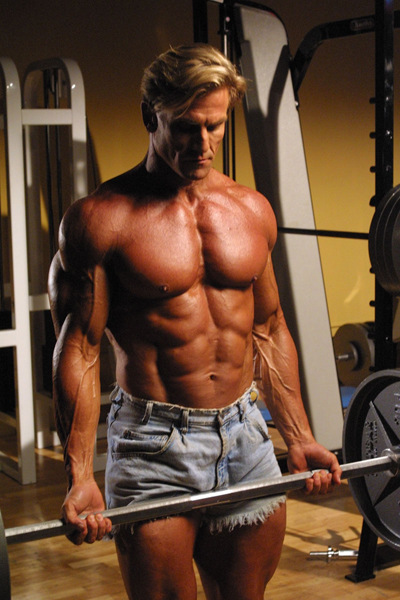
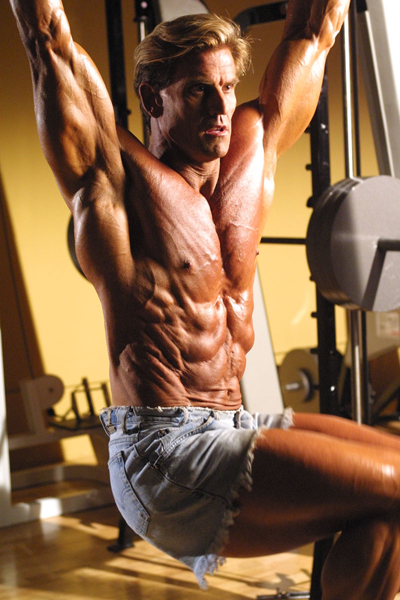

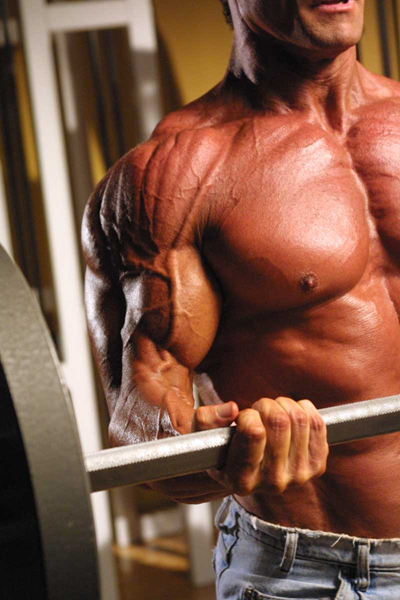
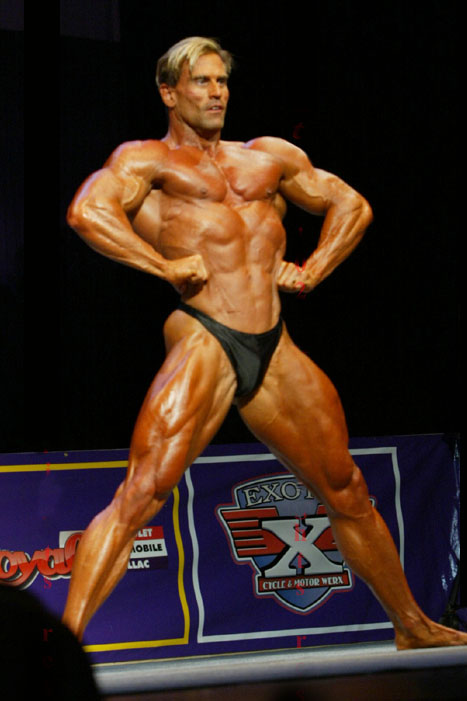
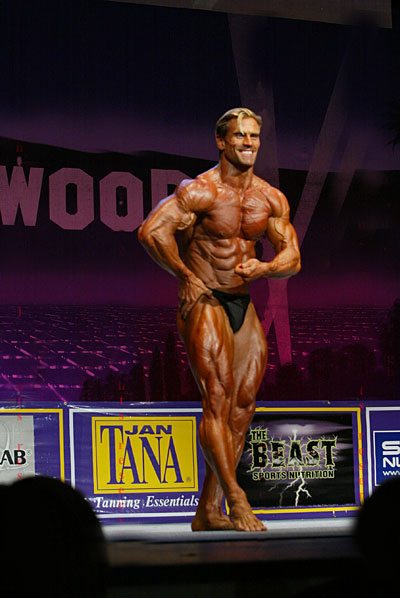
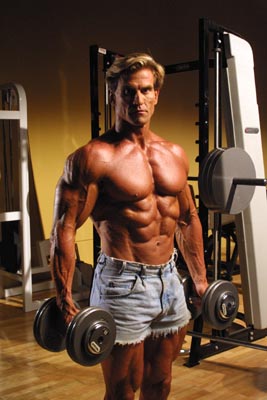
 Looking hard. Looking separated. That is what it is all about. Here are some tips to make that happen.
Looking hard. Looking separated. That is what it is all about. Here are some tips to make that happen. Usually the best time to do band work is at the end of your weight
Usually the best time to do band work is at the end of your weight 

